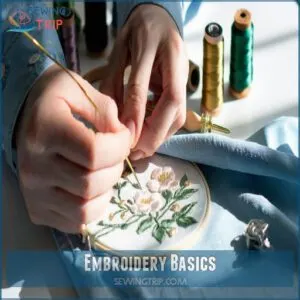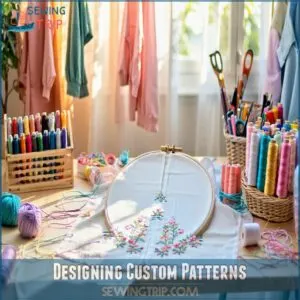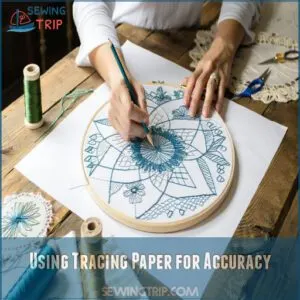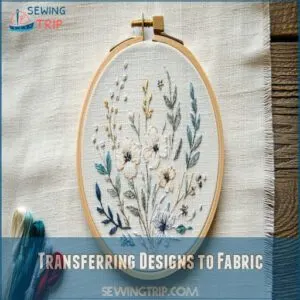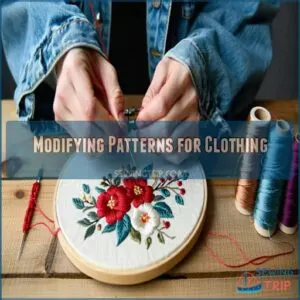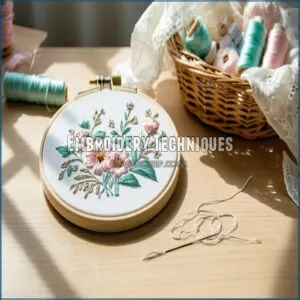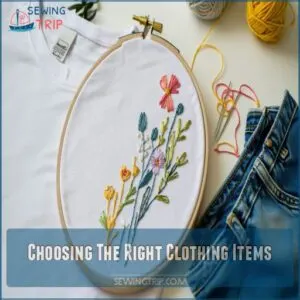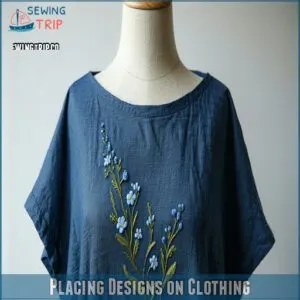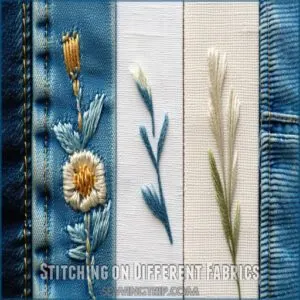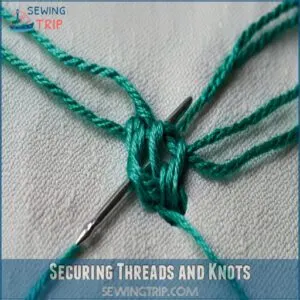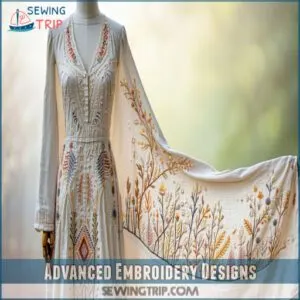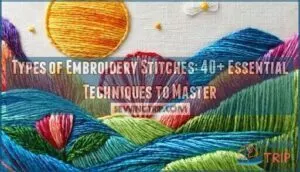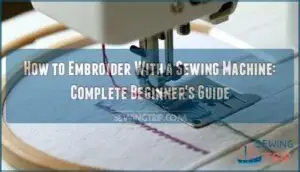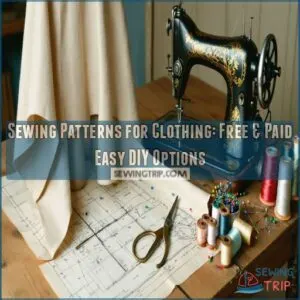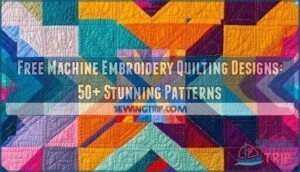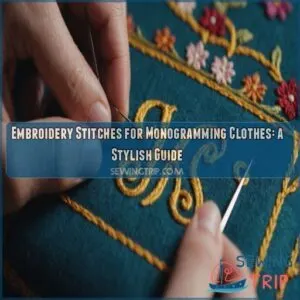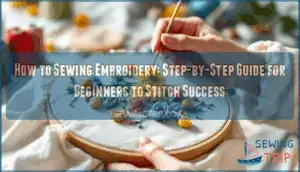This site is supported by our readers. We may earn a commission, at no cost to you, if you purchase through links.
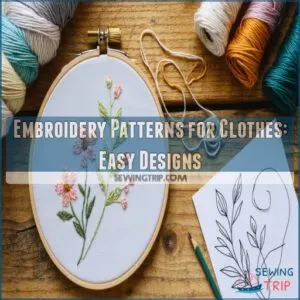
With a few basic stitches, like running stitch and back stitch, you can create unique designs.
Choose your fabric, thread, and stabilizer, and you’re ready to go.
Don’t worry if you’re a beginner – it’s easier than you think.
You can even design your own custom patterns using tracing paper.
Now, imagine adding a personal touch to your favorite clothes with beautiful embroidery patterns for clothes – the possibilities are endless, and you’re just getting started with unique designs and a personal touch.
Table Of Contents
Key Takeaways
- You’ll be able to create unique embroidery patterns for clothes by mastering basic stitches like the running stitch and back stitch, and experimenting with different fabrics and threads.
- To get started, you’ll need to choose the right fabric, thread, and stabilizer, and consider factors like fabric stretch, thread tension, and stitch length to ensure your design turns out great.
- You can use tracing paper to transfer your design onto fabric, and then stitch over it with embroidery floss and a needle – this will help you achieve accurate design placement and a professional finish.
- As you gain experience, you can move on to more advanced embroidery designs, like nature-inspired patterns, geometric shapes, and 3D effects, and even monetize your skills by selling custom designs or creating unique clothing items.
Embroidery Basics
You’re about to learn the basics of embroidery, and it’s easier than you think.
Just grab some thread, a needle, and your favorite clothes.
Now, let’s get started with the essentials, and you’ll be stitching like a pro in no time, creating cool designs on your clothes!
Essential Materials and Tools
You’ll need embroidery supplies like embroidery needles, thread types, and fabric scissors.
Grab an embroidery hoop and consider stabilizer options to get started with your embroidery floss and embroidery needle, making it easier to create beautiful designs with the right tools.
A wide variety of embroidery needles are available online, which can help you find the right tools, embroidery needles, and beautiful designs to enhance your embroidery experience.
Basic Stitches for Beginners
You’re starting with basic stitches, like Running Stitch and Back Stitch, perfect for beginner embroidery.
Try the Split Stitch, French Knot, and Colonial Knot too, and practice these embroidery stitches with a simple embroidery tutorial to master back stitch techniques.
Choosing The Right Fabric
You’re mastering basic stitches, now choose the right fabric.
Consider woven fabric, denim, or jersey cotton, and think about thread counts, weave patterns, and fiber content, as these affect embroidery on clothes, with denim being a popular choice for its durability and ease of embroidery.
For accurate design placement, use tracing paper for embroidery.
Preparing Fabric for Embroidery
Prep your fabric for embroidery by pre-washing to control shrinkage.
Choose woven fabric, like denim, and consider a stabilizer for stretchy materials.
For detailed guidance, explore this helpful fabric cutting guide for embroidery.
This step guarantees your design looks great and lasts long on your clothes, making embroidery on clothes a breeze with the right fabric selection and thread choice.
Creating Embroidery Patterns
You’re about to create your own embroidery patterns, which is super exciting, and you’ll get to choose the designs, colors, and fabrics you love.
Now, you’ll learn how to make custom patterns, use tracing paper for accuracy, and transfer your designs to fabric.
It’s easier than you think, and you’ll be stitching like a pro in no time!
Designing Custom Patterns
You’re creating custom embroidery patterns, making your clothes truly unique.
Try drawing or tracing a design, considering fabric selection, thread choices, and color schemes for your DIY embroidery patterns, and have fun making custom embroidery designs for your clothing embroidery projects with these easy embroidery patterns.
Pre-washing garments is essential, as explained in this helpful embroidery guide, to prevent shrinkage and puckering after your design is complete, which is a key part of custom embroidery.
Using Tracing Paper for Accuracy
You’re getting closer to stitching like a pro.
Use tracing paper for accuracy; it’s a game-changer.
Tracing paper tips help with design transfer, ensuring pattern accuracy and perfect fabric placement.
This makes your embroidery patterns and designs turn out beautifully with great stitch guidance.
Transferring Designs to Fabric
You’re almost ready to start stitching.
To transfer your design, try these:
- Using tracing paper
- Printable embroidery patterns
- Embroidery templates, and pick a stabilizer for smooth fabric prep, then select your thread, and place your hoop for easy design transfer.
The key steps are intertwined with choosing the right materials, including selecting a suitable thread and placing the hoop correctly for easy design transfer.
Modifying Patterns for Clothing
Now that you’ve transferred your design, it’s time to modify it for clothing embroidery.
Considering pattern scaling, fabric choice, and thread selection to guarantee a great fit, especially for embroidery on denim or tshirts, is crucial.
Adapting your embroidery designs with stitch modification for perfect clothing embroidery is essential to achieve the desired outcome.
Embroidery Techniques
You’re about to learn some cool embroidery techniques that’ll make your clothes look amazing.
Now, you’ll get to master the running stitch, back stitch, and other stitches, and learn how to use stabilizers to make your embroidery journey easier and more fun.
Running Stitch and Back Stitch
You’re stitching like a pro.
Try these:
- Adjusting stitch length
- Checking thread tension
- Using the right needle size for running stitch and back stitch embroidery patterns on clothes with varying fabric stretch.
For a closer examination of these techniques, explore this helpful backstitch vs. running stitch comparison.
Split Stitch and Other Stitches
You’re mastering the running stitch and back stitch, now try the split stitch, it’s a game-changer.
Experiment with stitch variations, thread choices, and fabric selection to create unique embroidery patterns, combining split stitch with running stitch and back stitch for stunning effects in your embroidery stitches.
Using Stabilizers for Support
You’ll need a stabilizer for fabric support, choosing from tear-away, water-soluble, or permanent types, to guarantee stitch stability and proper thread tension, especially with larger hoop sizes, and prevent embroidery backing issues.
For all your stabilizer needs, explore this helpful embroidery stabilizer product resource, which can provide more information on embroidery stabilizer and proper thread tension.
Avoiding Common Mistakes
Now that you’ve got your stabilizer in place, let’s tackle those pesky problems that can pop up in your embroidery journey.
Even experienced stitchers hit snags sometimes, but here’s how to dodge the common pitfalls:
- Thread breakage happens when your tension’s too tight – keep it relaxed like a Sunday morning
- Fabric shrinkage sneaks up if you skip pre-washing
- Hoop tension needs to be just right – not too loose, not too tight
- Stitch errors crop up from rushing – take your time, friend
The key to avoiding these issues is to be mindful of your thread breakage, hoop tension, and stitch errors, and to remember that patience is a virtue in embroidery.
Embroidering on Clothes
You’ll be amazed at how a few simple stitches can transform your plain t-shirt or boring jeans into a unique masterpiece that’s totally Instagram-worthy.
Whether you’re a complete beginner or you’ve got some experience under your belt, adding embroidery to your clothes isn’t just fun – it’s also an easy way to breathe new life into your wardrobe without breaking the bank, and this can be considered a way to give your clothes a unique touch and make them Instagram-worthy.
Choosing The Right Clothing Items
Ready to start your clothing embroidery journey?
Cotton, denim, and linen are your perfect first picks for embroidery fabrics.
T-shirts and jeans make excellent garment choices for beginners, while lightweight summer dresses can showcase simpler patterns.
Steer clear of stretchy textile options until you’re more experienced.
For clothing customization practice, plain cotton tees offer an ideal canvas .
Placing Designs on Clothing
Most embroiderers struggle with design placement, but you’ll nail it with the right approach.
For perfect embroidery alignment on t-shirts, position your design in a spot that feels natural and catches the eye.
Here’s your foolproof guide to placing embroidery patterns for clothes:
- Position left chest designs 7-9 inches down from shoulder seam
- Center larger designs for balanced clothing embroidery
- Use paper templates for precise embroidery designs
- Consider garment shape when transferring embroidery patterns
- Align designs between placket and side seam on polos
The key to successful embroidery design placement is to follow these steps carefully and consider the overall look of the garment, including the natural placement of the design and the garment shape.
Stitching on Different Fabrics
Your fabric choice can make or break your embroidery project.
Think of fabric like a canvas – tighter weaves give you smoother stitching, while looser ones might swallow your threads.
The choice of fabric depends on the type of embroidery project you are undertaking, with different fabrics suited for different designs and techniques.
| Fabric Type | Best For | Watch Out For |
|---|---|---|
| Denim | Bold patterns | Needle resistance |
| Cotton | Detailed work | Stretching |
| Linen | Traditional designs | Uneven weave |
| Jersey | Simple patterns | Need stabilizer |
| Silk | Delicate designs | Fragile handling |
Understanding the characteristics of each fabric type is crucial for a successful embroidery project, as it helps in selecting the most appropriate fabric for the desired outcome, considering factors such as needle resistance and the need for stabilizers.
Securing Threads and Knots
Once you’ve mastered stitching on different fabrics, let’s make sure your embroidery stitches stay put.
Your thread tension can make or break your design – too loose and it’ll sag, too tight and your fabric might pucker.
For a thorough guide to various stitches, explore decorative embroidery stitches for clothing.
Double knots are your best friends here, especially when working with embroidery floss on clothing, to ensure secure stitching and prevent fraying.
To achieve this, follow these steps:
- Tie a secure double knot on the underside, leaving a 1/4 inch tail for fray prevention
- When ending a running stitch or back stitch, weave the thread through previous stitches
- For extra security, create tiny tacking stitches near your main design to keep your embroidery in place and make it look professionally finished.
Advanced Embroidery Designs
You’re ready to take your embroidery skills to the next level, and that’s awesome!
Now, you’ll get to explore advanced embroidery designs, like nature-inspired patterns, geometric shapes, and more.
You’ll see how you can combine stitches to create unique effects.
Nature-Inspired Patterns and Designs
You’re exploring nature-inspired patterns, how cool!
Floral motifs, leaf designs, and bird patterns are popular.
Try tree embroidery or flower wreaths for a unique touch.
Botanical embroidery and floral embroidery patterns bring the outdoors in, making your clothes truly special with nature embroidery designs and beautiful floral embroidery.
Geometric and Abstract Designs
You’re moving from nature-inspired patterns to geometric and abstract designs, where symmetry patterns, abstract shapes, and geometric forms shine.
Apply color theory to create stunning textile art with modern embroidery patterns, combining simple embroidery patterns for unique geometric embroidery patterns and embroidery designs, utilizing geometric forms and color theory to enhance the overall aesthetic.
Creating Three-Dimensional Effects
You’re looking to add depth to your embroidery patterns. Try these methods:
- Couching techniques
- Padding methods
- Raised stitching, using dimensional threads for textured effects in your embroidery designs and stitches.
Combining Stitches for Unique Effects
You’re combining stitches for unique effects, creating texture with running stitch, back stitch.
| Stitch | Effect | Combo |
|---|---|---|
| Fly | Angular | French knots |
| Herringbone | Argyle | Running stitches |
| Chain | Simple | Cross stitches |
The table above outlines various stitches and their combinations, including the Herringbone stitch, which can be used to create argyle patterns with running stitches.
Frequently Asked Questions (FAQs)
What are hand embroidery patterns?
You’ll find hand embroidery patterns are designs you stitch by hand, often featuring flowers, leaves, or inspirational quotes, using various stitches and techniques to create unique, personalized pieces.
Where can I download embroidery patterns for free?
You can download free embroidery patterns from various websites, such as embroidery blogs, craft sites, or online marketplaces, offering a wide range of designs and styles to choose from easily.
Are there free embroidery patterns for beginners?
You’ll find plenty of free embroidery patterns online, with over 70% of beginners starting with simple designs, and yes, there are many free resources available for you to get started.
How do you use embroidery patterns?
You transfer the design, sew through it, and tie knots to secure threads, then remove the paper to reveal your unique embroidery creation, making it a fun, creative process.
How many free embroidery patterns are there?
You’re in luck, there are numerous free embroidery patterns, over 30 top-selling designs, and more, waiting for you to explore and get creative with your embroidery projects, it’s a treasure trove.
Can You embroider on clothes?
You can definitely embroider on clothes, it’s a great way to personalize them, and with the right tools and techniques, you’ll be stitching like a pro in no time, easily.
How do you get embroidery patterns on clothes?
You can get embroidery patterns on clothes by tracing a design onto tracing paper, pinning it to your garment, and stitching over it with embroidery floss and a needle.
Can you make money embroidering clothes?
You can monetize your embroidery skills by selling custom designs, offering alteration services, or creating unique clothing items to sell online or at local markets, earning a decent income.
What clothing is easiest to embroider?
You’ll find woven fabrics, like denim or cotton, are easiest to embroider, as they provide a smooth surface for stitching and don’t stretch or distort easily.
What colors work best for summer clothing embroidery?
You’ll love using bright, pastel colors like pink, baby blue, and mint green for summer clothing embroidery, they’re perfect for a fresh, playful vibe.
Conclusion
Now you’re all set to create stunning embroidery patterns for clothes, imagine wearing your favorite outfit with a personal touch.
You can easily design and stitch unique embroidery patterns for clothes, and with practice, you’ll be a pro at making beautiful embroidery patterns for clothes that reflect your style.
With time and effort, the idea of creating unique embroidery patterns will become second nature, allowing you to express yourself through your clothing.
- https://crewelghoul.com/blog/types-of-embroidery/
- https://www.vam.ac.uk/articles/embroidery-styles-an-illustrated-guide
- https://romanticrecollections.com/blog/2020/05/18/historical-embroidery-part-1/
- https://www.gathered.how/needlework/embroidery/library-of-embroidery-stitches-for-beginners
- https://www.lovecrafts.com/en-us/l/cross-stitch-and-embroidery/cross-stitch-and-embroidery-patterns/free-embroidery-patterns

